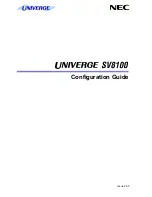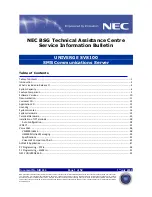
LSI Corporation
- 28 -
12Gb/s MegaRAID SAS Software User Guide
March 2014
Chapter 2: Introduction to RAID
RAID Levels
RAID 50, a combination of RAID 0 and RAID 5, uses distributed parity and disk striping. A RAID 50 drive group is a
spanned drive group in which data is striped across multiple RAID 5 drive groups. RAID 50 works best with data that
requires high reliability, high request rates, high data transfers, and medium-to-large capacity.
NOTE
Having virtual drives of different RAID levels, such as RAID 0 and
RAID 5, in the same drive group is not allowed. For example, if an
existing RAID 5 virtual drive is created out of partial space in an array,
the next virtual drive in the array has to be RAID 5 only.
RAID 60, a combination of RAID 0 and RAID 6, uses distributed parity, with two independent parity blocks per stripe in
each RAID set, and disk striping. A RAID 60 virtual drive can survive the loss of two drives in each of the RAID 6 sets
without losing data. RAID 60 works best with data that requires high reliability, high request rates, high data transfers,
and medium-to-large capacity.
NOTE
The MegaSR controller supports the standard RAID levels – RAID 0,
RAID 1,RAID 5, and RAID 10. The MegaSR controller comes in two
variants, SCU and AHCI, both supporting a maximum of eight physical
drives. A maximum of eight virtual drives can be created (using RAID 0,
RAID 1, RAID 5, and RAID 10 only) and controlled by the MegaSR
controller. One virtual drive can be created on an array (a maximum of
eight if no other virtual drives are already created on the MegaSR
controller), or you can create eight arrays with one virtual drive each.
However, on RAID 10, you can create only one virtual drive on a
particular array.
2.2.2
Selecting a RAID Level
Select the optimal RAID level when you create a system drive. The optimal RAID level for your drive group depends on
a number of factors:
The number of drives in the drive group
The capacity of the drives in the drive group
The need for data redundancy
The disk performance requirements
2.2.3
RAID 0
RAID 0 provides disk striping across all drives in the RAID drive group. RAID 0 does not provide any data redundancy,
but RAID 0offers the best performance of any RAID level. RAID 0 breaks up data into smaller segments, and then
stripes the data segments across each drive in the drive group. The size of each data segment is determined by the
stripe size. RAID 0 offers high bandwidth.
NOTE
RAID level 0 is not fault tolerant. If a drive in a RAID 0 drive group fails,
the entire virtual drive (all drives associated with the virtual drive) fails.
By breaking up a large file into smaller segments, the RAID controller can use both SAS drives and SATA drives to read
or write the file faster. RAID 0 involves no parity calculations to complicate the write operation. This situation makes
RAID 0 ideal for applications that require high bandwidth but do not require fault tolerance. The following table
provides an overview of RAID 0. The following figure provides a graphic example of a RAID 0 drive group.
Summary of Contents for ThinkServer RD650
Page 1: ...ThinkServer 12 Gb s MegaRAID SAS Software User Guide ...
Page 417: ......
Page 418: ......
















































